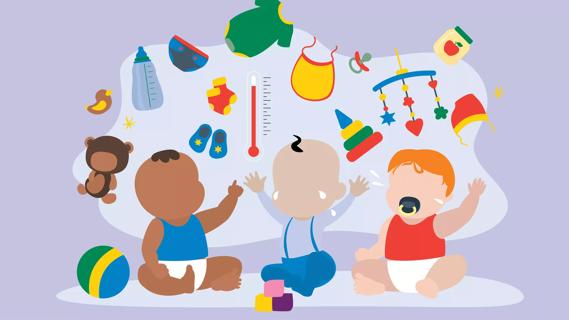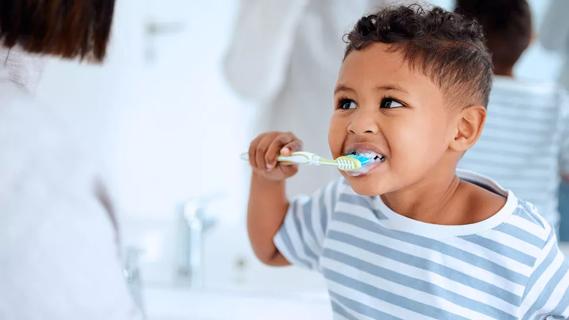From split lips to splinters, a little first-aid can get your kiddo back on the swing set in no time

One look at a colorful collection of playground equipment typically brings a request from children: “Can I go play? Please!!!” Kiddos just can’t stay away from those swings and slides and climbing walls.
Cleveland Clinic is a non-profit academic medical center. Advertising on our site helps support our mission. We do not endorse non-Cleveland Clinic products or services. Policy
But as fun as playgrounds may be, they’re also the source of many boo-boos. Playground injuries send more than 200,000 kids a year to U.S. emergency rooms. That’s an average of one ER visit roughly every 2.5 minutes. OUCH!
So, what should you do after a big fall or some other mishap ends in a pain-filled scream? Let’s put together a first-aid game plan for 12 common playground injuries with pediatricians Lisa Diard, MD, and W. Kyle Mudd, DO.
The first goal in treating a cut is simple: “Get the bleeding under control,” instructs Dr. Diard.
To do that, apply pressure to the wound until the bleeding stops. (It shouldn’t take more than a few minutes.) Then, thoroughly rinse the area with warm, soapy water. It’s best not to use rubbing alcohol or hydrogen peroxide, which can slow healing.
Apply a bit of antibiotic ointment and cover the cut with a bandage until a scab forms. Studies show that covered wounds heal up to 40 times faster than those left uncovered, adds Dr. Mudd. Using a lotion with vitamin E can help prevent scarring.
Seek out medical attention for cuts that:
As you might expect, the basic guidelines for dealing with a split lip are similar to the above instructions for handling a cut. But it’s important to know that this injury might be a bit messier.
“The mouth bleeds a lot, so don’t be alarmed,” warns Dr. Diard.
Rinse the wound area to find the source of all blood and then apply pressure with a clean cloth to stop the bleeding. Don’t be surprised if it takes as long as 10 minutes to get the bleeding under control.
Wash the area with soap and water to remove any dirt. Do this gently. No scrubbing!
Applying a cold pack to the wound can help minimize swelling. If you’re using ice, make sure it’s wrapped in a towel to avoid direct contact with the skin. (Putting ice directly on a split lip or any skin can cause a burn.)
See a healthcare provider if the bleeding won’t stop or if the wound is large or looks to be filled with debris.
Like a split lip, a bloody nose can be pretty … well, bloody. (You’ve been warned!)
While the blood is flowing, keep your child leaning forward with their head tilted down. Yes, it sounds a bit messy — but it’s better for any blood to spill out as opposed to running down their throat.
Pinch together their nostrils to help stop the flow of blood, advises Dr. Mudd. (A tissue or damp washcloth could come in handy here.)
Wait five minutes to check to see if the bleeding has stopped. If it hasn’t, pinch and hold the nostrils again. Seek medical help if bleeding continues after 15 minutes or your child loses a cup’s worth of blood.
If your kid comes home with a black eye, leave the steak in the fridge or freezer. A ruined dinner is all you’ll accomplish by turning to that old-school remedy.
Instead, place a cold, wet compress over the eye for 10 to 20 minutes to limit swelling. Stay away from using an ice pack. “The skin around your eye is too sensitive for that kind of cold,” says Dr. Diard.
Avoid using a chemical-based cold pack, too, as they may leak and cause additional damage to the eye.
Dr. Diard suggests checking in with a healthcare provider if:
Friction burns go by many aliases. Road rash, for instance. Carpet burn. Raspberries.
Treating this uncomfortable skin condition begins with a gentle cleaning, says Dr. Mudd. There’s no need to get fancy here. Just basic soap and lukewarm water will get the job done.
Do NOT apply ice or use ice water. Either could further traumatize the skin and ultimately slow the healing process.
Once the area has been rinsed, check for any debris or foreign objects in the rubbed-raw skin. (You might be surprised by what you find.) Use sterilized tweezers to carefully remove anything that doesn’t belong.
Apply antiseptic and cover with a gauze pad, making sure the adhesive isn’t on the burned area. Check the healing daily and contact a healthcare provider if you notice signs of infection like increased swelling, redness, pain or pus.
Here’s a fast fact for you: Approximately 1 in 3 children fracture a bone before hitting adulthood.
So, how do you know if a bone is broken if it’s not gruesomely obvious? Signs include:
Apply a cold pack to the injured area right away to reduce swelling. Keep movement to a minimum. “Use anything you can find — even something as simple as cardboard — as a make-shift splint,” instructs Dr. Mudd.
Call 911 and don’t move the injured child if the injury seems serious. That would include possible breaks to the skull, back or neck, or if the bone broke through the skin.
If you suspect a broken bone, get the injury checked by a medical professional ASAP for proper treatment. “Waiting too long to be seen can lead to poor healing and continued pain,” states Dr. Diard.
So, we covered busted bones. Now let’s look at soft tissue injuries — aka, sprains.
A sprain involves a ligament that’s stretched or even torn within a joint (such as an ankle, knee or wrist). A popping sound may be heard when the injury occurs. Any pain, tenderness or bruising is usually focused around the affected joint.
For treatment, follow the RICE method, says Dr. Mudd. That means:
On average, it takes at least two weeks to recover from a mild sprain. Contact a healthcare provider for a checkup if the pain continues or worsens over time. (That “sprain” may turn out to be a broken bone.)
To state the obvious, your brain is an essential organ with a long list of duties. ANY INJURY to your brain should be taken seriously.
A concussion qualifies as a brain trauma. If your child hits their head and shows signs of a concussion, seek medical attention, stress both Dr. Diard and Dr. Mudd. Concerning symptoms include:
Err on the side of caution, too. “Even if your child seems fine, if they fall more than 3 feet and hit their head they should be examined,” says Dr. Diard. (Learn more about children and concussions.)
Let’s start with the #1 rule: Don’t break or “pop” a blister. “This can introduce infection into the wound,” notes Dr. Mudd.
What you should do, though, is wash the blister area with soap and water. Then, apply antibacterial ointment and cover the blister with a bandage or gauze secured with hypoallergenic tape.
Covering the blister will help protect the skin and prevent infection. Change the dressing at least once daily until it’s healed.
If the blister does burst, don’t peel off the dead skin. Leaving it in place can help keep dirt and bacteria out of the opening. Cover the popped blister with a bandage or gauze, just as you would if it was still intact.
Removing a splinter from a child’s finger can be a sensitive operation. The good news? You’ve got options.
If you’re lucky, you may be able to remove the splinter just using masking tape. Just put the sticky strip over the splinter and press it down. Then, gently pull up to see if it dislodges the splinter. (It’s worth a shot!)
Tweezers are another good choice, especially if part of the splinter is sticking out of the skin and easy to grab.
Splinters that are a little deeper may need to be coaxed out with a sterilized needle or pin.
Wait until that pesky splinter is removed before washing that area with soap and water. “Wood-based splinters can expand with water, which will make them more difficult to get out,” explains Dr. Diard.
As a general rule of thumb, don’t dig at a splinter for more than five minutes, says Dr. Mudd. Bring your child to their pediatrician at this point. This can help prevent your child from feeling anxiety over the situation. (Plus, removal is often easier in the office.)
Watch for signs of infection in the days after a splinter is removed.
Everyone’s initial instinct when something gets in one of their eyes is to rub at it. Unfortunately, that’s about the worst thing you can do. “You can cause a lot of damage that way,” warns Dr. Diard.
So, if your kid comes to you complaining of something in their peeper, the first thing to do is keep their hands away from their face.
The next step? To the sink!
Flushing out an eye is the best way to remove a foreign object, says Dr. Diard. That can be done in the shower or by pouring water over your child’s head so that it runs through their affected eye.
If you can see the object in the corner of the eye, try to remove it with a cotton ball, tissue or even a well-washed finger. (Stick to irrigating if the object is on their cornea.)
Schedule an appointment with an eye doctor if pain lingers or there’s a change in vision.
So, what should you do if a tooth gets completely knocked out? Put it back in, of course!
Start by picking up the tooth by the crown, the normally exposed part. Gently rinse the root off with water if it’s dirty. (Don’t scrub at it or remove any tissue.) Once it’s clean, reinsert the tooth into the vacant spot.
“Press on the tooth with your thumb and then, have the child bite down on it,” says Dr. Diard. “Then, go to an urgent dental care center.”
If you can’t get the tooth back in place, place it in a small container of milk and head to a dental office. (Milk has substances that help the tooth stay alive while it’s outside its natural mouth habitat.)
Knocked-out teeth are more likely salvageable if reinserted within an hour of being knocked out, notes Dr. Mudd.
A little first-aid can go a long way to soothing boo-boos, drying those tears and recognizing how and when to get your kiddo the care they need.
Learn more about our editorial process.

You can help strengthen your child’s immune system by focusing on hand washing and staying up-to-date on their vaccines

A dental emergency, quick action is key to preventing long-term damage

Help and encourage them to brush and floss regularly, limit sugary foods and get routine dental checkups

Kids’ yoga can help kiddos become more aware of their physical, mental and emotional selves

It’s never too early to teach your kids who strangers are and how to avoid unsafe situations

Too much screen time and unrealistic expectations and perceptions and can lead to an increased risk of anxiety and depression

They’re nontoxic, but crayons can cause an upset stomach and pose a serious choking hazard

An ounce of prevention ... is worth a great school year!

Your metabolism may torch 1,300 to 2,000 calories daily with no activity

A gentle touch in all the right places may help drain your sinuses